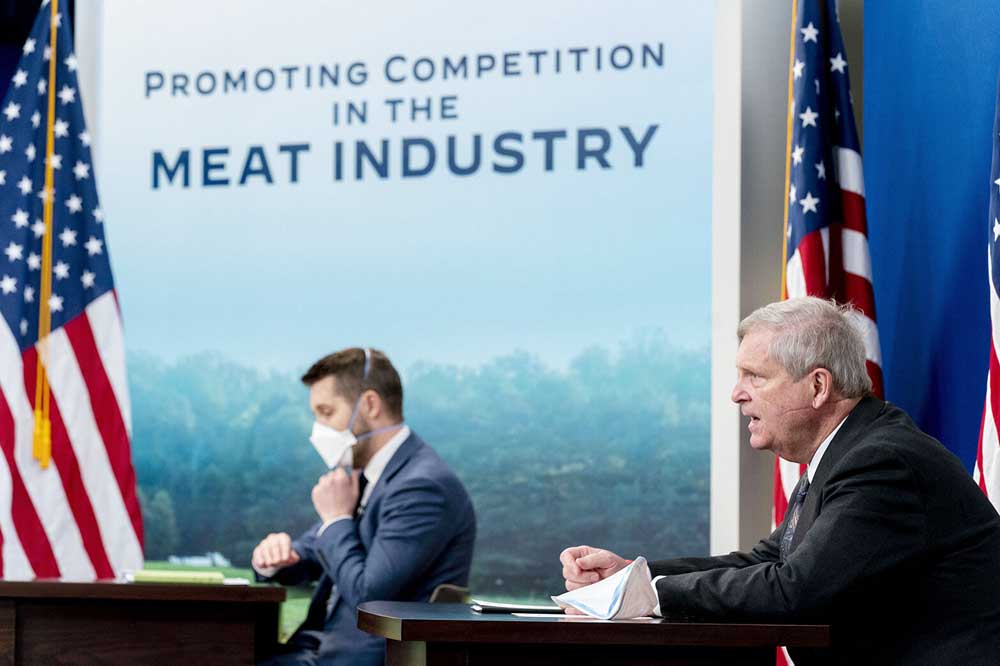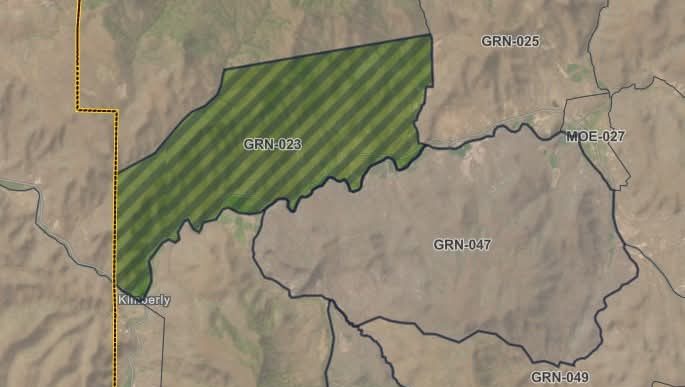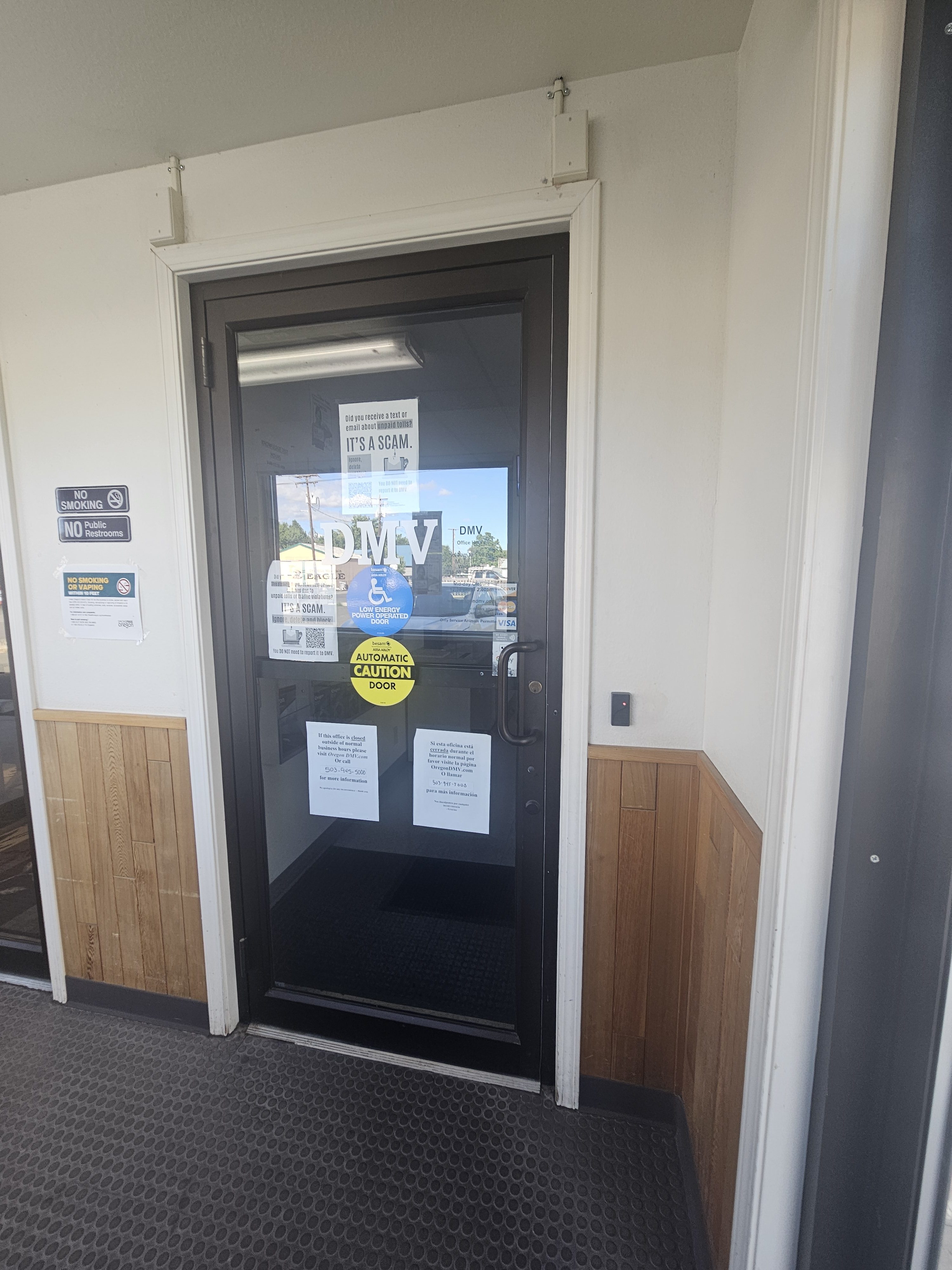BEEFING UP PROCESSOR CAPACITY: How will USDA’s $1 billion investment impact cattle producers?
Published 7:00 am Thursday, February 17, 2022

- Agriculture Secretary Tom Vilsack, right, accompanied by National Economic Council Director Brian Deese, left, speaks during a virtual meeting with family and independent farmers and ranchers Jan. 3 to discuss work to boost competition and reduce prices in the meat-processing industry.
WASHINGTON — After college, Patrick Robinette managed a feedlot in Nebraska for five years. When his father-in-law fell ill, he and his wife, Amy, returned to the family farm in North Carolina to manage the cattle operation.
Trending
About 10 years ago, they reopened a shuttered processing plant in Micro, N.C., with a capacity of 100 head per day.
In the 12 years before opening the facility, Robinette said he was at the mercy of the cattle markets and had his share of losses.
“The system is a complete market manipulation,” he said, adding that the strings are being pulled by processors, distributors, retailers and even USDA.
Trending
“I’m not satisfied with ‘this is as good as it gets,’” he said.
In part, he said, that’s why he joined U.S. Cattlemen’s Association, where he serves as chairman of the independent processors committee.
Like many cattlemen, he contends the four major packers — Tyson Foods, Cargill, National Beef and JBS — have too much leverage, controlling 85% of the market.
For years, cattle producers have voiced frustration over packer concentration, saying it gives producers little bargaining power and shows up in low prices for their cattle.
The Biden administration agrees and has taken it one step further, accusing the Big Four of pandemic profiteering and blaming them for the recent increases in the price of meat.
Government intervention
On Jan. 3, the administration announced it would invest $1 billion to expand meat and poultry processing capacity — with a focus on small and mid-sized independent processors — to increase competition.
“Without meaningful competition, farmers and ranchers don’t get to choose who they sell to,” President Joe Biden said in announcing the investment.
Producers have to take the prices processors want to pay, and corporations can use their power to overcharge grocery stores and, ultimately, families, he said.
“And the big companies are making massive profits,” he said.
Expanding local meat processing is critical to keeping dollars in the communities where the wealth is being generated, said USDA Secretary Tom Vilsack.
“For far too long we’ve had an extraction economy in rural America where these guys work 24/7, 365 days a year raising cattle, and then they transport them hundreds of miles away and the profits basically go thousands of miles away,” he said.
USDA has not specified how much additional capacity is being targeted or for which species, but much of the discussion on the need for more capacity focuses on the cattle sector.
Cattle processing capacity was tight even before the pandemic, but it was greatly exacerbated by plant worker illness and new safety protocols. The spread between boxed beef prices and fed cattle prices was off the charts early in the pandemic.
By the second week of May 2020, the spread reached $279 per hundredweight, the largest since mandatory price reporting began in 2001. The average spread from 2016 through 2018 was $21, according to a USDA investigation.
By the last week of April, nearly 40% of U.S. beef processing capacity was idled due to COVID-19 illness among plant employees, reducing packer demand for cattle. At the same time demand for beef skyrocketed as consumers reacted to the possibility of shortages in grocery stores, USDA reported.
Nonetheless, cattle producers’ accusations of market manipulation reached fever pitch.
In addition to expanding independent processing, the administration intends to increase market transparency, strengthen producer protections and enforce existing antitrust laws.
“Expanded processing opens opportunities and pathways for cattle producers to diversify their marketing,” Robinette said.
They can still sell to feedlots, but they can also process animals through smaller facilities and sell retail and whole and half carcasses. With more options and increased competition, it’s also an opportunity to make major packers “take cattle producers seriously,” he said.
“You get a facility built, you open another lane for producers to go. You’ll be able to be the wholesaler and retailer and be all the other hands that have been in your pocket,” he said.
Ultimately, that raises returns to producers. On the flip side, if cattle are diverted away from the established system, packers are going to have to get more aggressive in what they pay cattle producers, he said.
“Packers are getting an exorbitant amount of profit, and they’re not sharing,” he said.
The last price spread he’s seen showed a $1,900 per head spread between what packers were paying cattle producers and the price they received for the beef,” he said.
“That’s too big,” he said.
Not convinced
The bottlenecks that reduced cattle prices and raised beef prices were caused by an oversupply of cattle and a limited supply of labor to get beef to consumers, said Don Close, senior animal protein analyst for the agricultural lender Rabobank.
If cattle supplies and processor capacity come into balance, it will neutralize the situation, he said.
But he’s not convinced government investment to expand processing capacity is the solution or would be without unintended consequences.
The biggest challenge to beef processing capacity is labor availability, and new processing plants would likely have the same problem. He doesn’t see structural limitations in the current system and is impressed with how well plants, albeit old, are maintained and updated, he said.
“If we’re fully using capacity, I’m not convinced we need additional plants. I am not at all opposed to new plants, but there’s a huge risk of overbuilding before this is done,” Close said.
There are already two new beef processing plants under construction in Idaho, a new one opened in Missouri about a year ago, and JBS is expanding capacity at two Nebraska plants. In addition, National Beef plans to go to double shifts at its Iowa Premium plant, he said.
The new plants already in play would increase capacity by 4,000 head a day but won’t come online until 2024. There are also press releases from other companies wanting to expand, which might not come to fruition, he said, adding that the sum of all the current and proposed projects would increase capacity by 14,000 head a day, he said.
“Given the existing U.S. cattle herd, we need to expand capacity 4,000 to 5,000 (head) a day,” Close said.
On top of that, the cattle herd is declining. The U.S. cattle inventory peaked in January 2019, slaughter accelerated in 2021 due to drought and is likely to continue in 2022, he said.
“We’re contracting cattle supply at the same time we’re trying to build these facilities. New facilities entering the market will be met with a lot of competition,” he said.
USDA’s Jan. 1 cattle inventory report, released Jan. 31, showed a 2% reduction year over year. A reduction of 1% to 1.5% in 2022 would put the cattle supply at a low point in 2023, Close said.
The administration hasn’t released any parameters on the size of processing facilities it wants to promote in its new investment plan but it’s probably small to medium plants with capacities of up to 1,500 head a day, he said.
“There will be a number of them that prove to be highly successful. There will be a bigger share that are going to find a difficult business environment,” Close said.
It doesn’t make sense for the government to be injecting this money into expanding processing, he said.
In addition to more capacity already in the works and a shrinking cattle herd, there is an axiom in the business that a new processing facility has to change hands three times before it becomes profitable.
“Typically, that holds very true,” Close said.
“The idea of building a number of small plants regionally obviously has a high level of appeal when you say it,” he said.
But there’s a reason larger plants are located where they are — access and availability of local cattle, a regional workforce and freight advantages, he said.
Any increase in capacity of new players will increase cattle prices temporarily, but he doesn’t think it would last. That would figure into the price of beef, and that price can only run up so much before consumers are unwilling to pay, Close said.
Cattle prices and inflation
The industry and the administration have talked extensively about the four largest meatpackers controlling 85% of the market, but that structure hasn’t changed in the last 10 years and only changed 5% in the last 20 years, Close said.
But cattle producers have been upset, and there’s been a lot of public attention on food inflation, particularly meat, he said.
“Has that (concentration) been a handy scapegoat for the administration to divert attention? Yeah, I think it’s been real convenient,” Close said.
The U.S. cattle inventory increased by 6 million head from 2014 to 2019, and little was done to increase capacity during that time, he said.
“So a lot of this stress that is on the system today is from the cattlemen’s actions, not the packers’ actions. A lot of the issues cattlemen are fighting today have been brought on by an increase in supply and no increase in slaughter capacity,” Close said.
Packers have had attractive margins, but they’re probably overstated from the reality they’re dealing with. Entry level wages at packing plants have increased by one-third compared with pre-pandemic levels, and material and transportation costs have increased about 25%, he said.
“The same inflationary pressures impacting producers and consumers are impacting everyone in the middle of that chain as well,” he said.
Profitability factor
While the administration is talking about expanding all meat and poultry processing, most of the criticism of the system seems to be focused on the cattle sector, said Jayson Lusk, director of Purdue University’s Department of Applied Economics.
But cattle processing capacity is fuzzy. It’s not just brick and mortar and steel and iron. Processors have the ability to run on weekends, and they’ve done that. It also involves people; a plant can’t run without people, he said.
“So capacity is a bit more nebulous than it might seem,” Lusk said.
Cattle slaughter capacity has been pretty tight for a couple of years, and it’ll take two to three years to bring more capacity online. So the question becomes: What does the industry look like two to four years from now? Economists have been forecasting lower cattle numbers over the next few years, he said.
The government’s investment is “going to do nothing in the short run. In the longer run, adding more capacity — all things being equal — would bring higher prices for cattle producers,” Lusk said.
But all things aren’t equal, he said.
Even before the federal government announced investments, states and private industry were investing in processing capacity, he said.
His concern is “we wake up in a world three or four years from now and we have a lot of packing capacity relative to the amount of cattle on feed,” he said.
That would make it hard for packers, especially those that don’t have economies of scale. It’s not only possible but likely the government will pour money into expanding processing and those processors would go out of business, Lusk said.
“From a producer’s standpoint, adding more capacity will be supportive to cattle prices — but they have to stay in business,” he said.
The pandemic aside, times were lean the last few years for cattle producers because of the large number of cattle. But the industry is probably moving into a cattle cycle that’s going to be more profitable for producers, he said.
The administration is trying to be responsive to cattle producers and address retail inflation, he said.
“I don’t think it’s going to change anything soon. But it helps them tell the story they’re doing something,” Lusk said.
The cattle cycle ebbs and flows, and profitability determines the size of the packing industry. The focus needs to be on making it more profitable in the long run to have more capacity in the system, he said.
Options and competition
Back in North Carolina, Robinette said the U.S. Cattlemen’s Association welcomes the government’s investment.
“It’s a starting point, it gets us going,” he said.
While $1 billion is minute in the bigger picture, it will encourage other lenders to invest in rural communities — boosting rural economies, he said.
“Government investment will move the needle, You’ll start seeing private investment banks jumping on the bandwagon, too,” he said.
And cattle producers who are stuck in the system will have options, he said.
“It opens the door for new market avenues for our producers to be able to say, ‘I want more for my cattle,’” he said.
But it has to be smart investment — facilities with capacities between a Cargill and a country butcher shop, he said.
“The intent is to have local and regional systems,” he said.
The administration is still writing the rules, but his hope is it won’t result in thousands of very small facilities — that aren’t going to be impactful — or a couple of mega facilities.
“We have to take this opportunity to redefine the structure, create a model,” he said.









